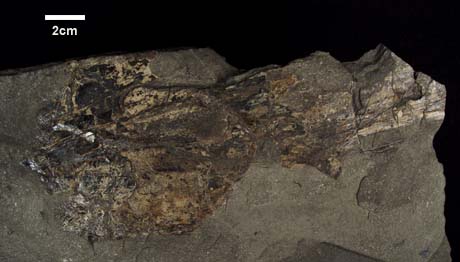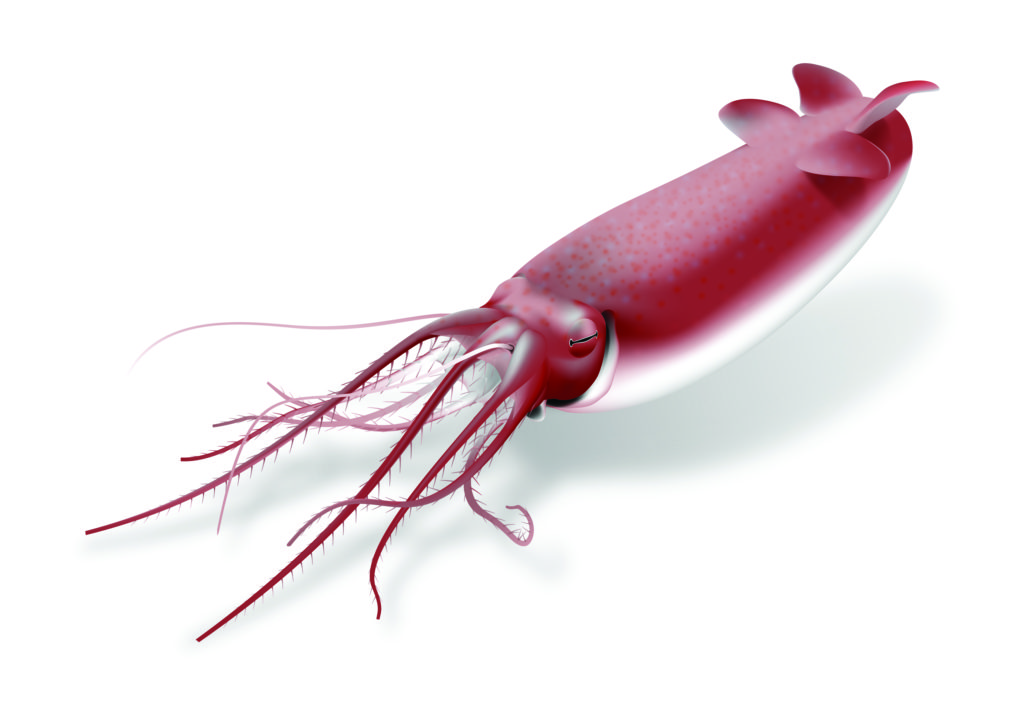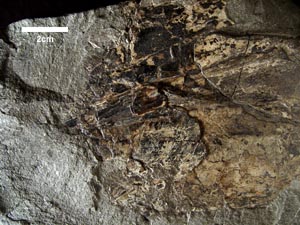Squid

Squids are among the rarities in the fossil record. There are only a few localities on a global scale where these fossils occur at all. This is due to the fact that squids almost exclusively consist of soft parts and consequently it is hardly possible to preserve this group of animals as fossils. From the Lower Cretaceous, the time span between 135 and 95 miilion years ago they have even been unknown until recently.the Geosciences Collection houses the fossil of a squid from the black shales (“Töck”) of the Lower Cretaceous of the Isle of Heligoland. The rock slab shows remains of the pen (inner skeleton) of the animal.

These squids do not posses chambers like Nautilus or ammonites to provide buoyancy for the animal in the water. The shell has been rather dislocated inside the body and lost its function of external protection. This enables the animal, contrary to its ancestors that are only known from fossils, a high mobility and the capability to hunt for prey. The ejection of ink additionally camouflages its escape.
In some squids there are hooks at the tips of the arms but no suckers. Actually one structure on the rock slab enclosing our squid might be the hook of an arm. Occassionally ink and ink sacks are recorded from fossils.
Black shales of the Mid Cretaceous
 The teuthoid squids hitherto recorded from Heligoland include four, possibly five genera: Mastigophora, Plesioteuthis, Boreopeltis, Maioteuthis and ?Trachyteuthis (Engeser & Reitner 1985). This unusually rich teuthoid fauna is based on the special preservation of the Isle of Heligoland “Töck” (Stühmer et al. 1982), that is a conservation deposit in the sense of the concept of fossil lagerstatten (Seilacher 1990). The fossil squid of the Geosciences Collection has not been scientifically described so far and can be preliminary determined as Mastigophora?. The fossils comes from the “Töck”, a black shale horizon with a thickness of 1 m that is Lower Aptian in age (Bartenstein & Kaever 1973). The “Töck” can be correlated with the Fischschiefer (fish shale) that is well-known from the eastern part of the Lower Saxony Basin. These black shales are interpreted as sediments deposited under stagnant water conditions. Probably a slight reduction of salinity lead to a saline stratification (Mutterlose & Böckel 1998). This led to an accumulation of organic matter on the sea floor, forming black shales that are rich in organic carbon (Corg). Although the “Töck” respectively the Fischschiefer is correlated with the globally distributed Oceanic Anoxic Event 1a (OAE 1a) some authors believe its deposition was steered by regional factors.
The teuthoid squids hitherto recorded from Heligoland include four, possibly five genera: Mastigophora, Plesioteuthis, Boreopeltis, Maioteuthis and ?Trachyteuthis (Engeser & Reitner 1985). This unusually rich teuthoid fauna is based on the special preservation of the Isle of Heligoland “Töck” (Stühmer et al. 1982), that is a conservation deposit in the sense of the concept of fossil lagerstatten (Seilacher 1990). The fossil squid of the Geosciences Collection has not been scientifically described so far and can be preliminary determined as Mastigophora?. The fossils comes from the “Töck”, a black shale horizon with a thickness of 1 m that is Lower Aptian in age (Bartenstein & Kaever 1973). The “Töck” can be correlated with the Fischschiefer (fish shale) that is well-known from the eastern part of the Lower Saxony Basin. These black shales are interpreted as sediments deposited under stagnant water conditions. Probably a slight reduction of salinity lead to a saline stratification (Mutterlose & Böckel 1998). This led to an accumulation of organic matter on the sea floor, forming black shales that are rich in organic carbon (Corg). Although the “Töck” respectively the Fischschiefer is correlated with the globally distributed Oceanic Anoxic Event 1a (OAE 1a) some authors believe its deposition was steered by regional factors.
References:
- Bartenstein, H. & Kaever, M. (1973): Die Unterkreide von Helgoland und ihre mikropaläontologische Gliederung. – Senckenbergiana Lethaea 54: 207-264.
- Engeser, T. & Reitner, J. (1985): Teuthiden aus dem Unterapt (“Töck”) von Helgoland (Schleswig-Holstein, Norddeutschland). – Paläontologische Zeitschrift 59(3/4): 245-260.
- Mutterlose, J. & Böckel, B. (1998): The Barremian-Aptian interval in NW Germany: a review. – Cretaceous Research 19: 539-568.
- Seilacher, A. (1990): Taphonomy of Fossil-Lagerstätten. – In: Briggs, D. E. G. & Crowther, P. R. (Hrsg.): Palaeobiology – a synthesis, Oxford, Blackwell, 266-270.
- Stühmer, H. H., Spaeth, C. & Schmid, F. (1982): Fossilien Helgolands, Teil 1: Trias und Unterkreide. – Otterndorf, Niederelbe-Verlag, 184.
